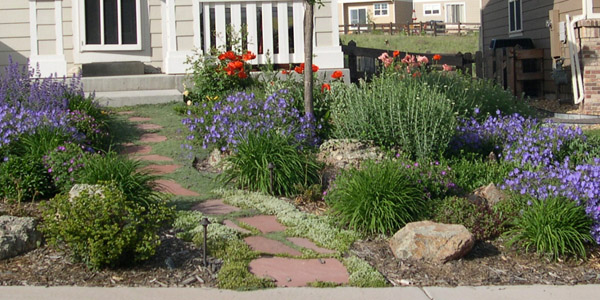
Xeriscaping
Xeriscaping is used to practice water conservation in creative landscapes. The word xeriscape comes from the Greek word xero for “dry” and scapes for “dryscape.” This application ensures water efficiency in all future landscape practices, especially for areas where water is scarce and expensive. This basic landscape practice has been used extensively in the southwestern United States. Over time the demand for water has increased rapidly. Therefore, landscape practices must change to meet these new water requirements.
The basic concepts of Xeriscaping involve the following applications of landscape principles:
Good design and planning.
Improving the soil
Turf areas
Use of ground covers
Low water use
Plant selection
Use of low-volume irrigation
Proper landscape maintenance
Reduced fertilizer use
Reduced pest infestation
Habitat and food sources for birds and butterflies
Increased use of native plants in the landscape
Conservation of a healthy environment
Good design and planning are important to proper xeriscaping because it is necessary to group plants in relation to their water needs. This grouping practice allows one to grow high-water- use plants and still maintain the water conservation needed. When designing a garden, use mass plantings with borders of lower plants in the front and taller plants in back Soil can be improved to provide optimum plant growth and conservation of water. The addition of organic matter will improve the aeration and water supply for the plants.
Organic matter is an excellent source of nutrients to plants. The use of soil amendments, such as gypsum, lime, and hydro-gels, aids in water retention and improved availability of water to the planted material.
Turf areas should be seeded in high-drought- tolerant grasses. The turf areas should be separate from other plantings and irrigated separately.
Mulches in the landscape are important to conserve moisture, reduce evaporation, keep the soil cool, and reduce weed growth. Mulches are organic and inorganic materials that provide aesthetic value to the landscape. A high portion of the water that falls is lost through evaporation or run off. Mulching will reduce this water loss by 90 percent.
Low volume irrigation is important to incorporate into the landscape. The use of water systems that deliver spray patterns for defined areas is necessary. The use of drip irrigation is a more direct way of pinpointing where the water is needed.
Proper landscape maintenance is needed to preserve the beauty of the landscape and conserve water. Weeding, pruning, pest control, and adjustments in the irrigation system help to conserve moisture in the landscape.
Ground covers give the landscape a wide variety of texture and color and retain soil moisture. Large turf areas transpire large quantities of moisture. Using ground covers in beds that are properly mulched will help to conserve moisture.
Select plant material with low water requirements. Many varieties of plants survive well with minimal watering. The varieties include native and exotic plants, cultivated ground covers, trees, and shrubs.
____________________________
Contact us today and Experience the Different Services, Our work Quality and Our Values
For all your Landscaping Needs.
Free estimates, Honest & Affordable
Give us a call or Email us at
marioperez@amlandscapeinlasvegas.com
office: 702-832-6293
Mario Perez Cell: 702-410-3678
____________________________